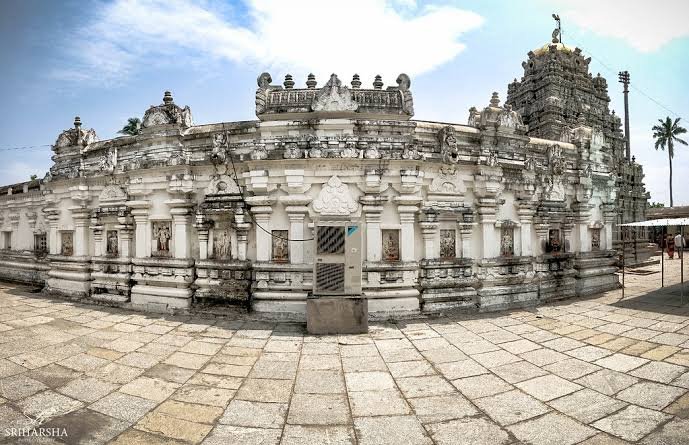Sri Kurmanathaswamy temple Srikurmam
Sri Kurmanathaswamy Temple (also known as Srikurmam temple) is a Hindu temple in the Gara mandal of the Srikakulam district in the state of Andhra Pradesh. It is dedicated to the Kurma avatar of the Hindu god Vishnu, who is worshipped as Kurmanathaswamy, and his consort Lakshmi, worshipped as Kurmanayaki. According to Hindu legend, the presiding deity is believed to have manifested here in the form of a tortoise-shaped idol upon the wishes of Swetha Chakravarthi. Brahma then consecrated the idol with Gopala Yantra. The temple is famous for ancestor worship.
History
In this temple Lord Vishnu is worshiped in his Kurma avatar. Initially dedicated to Shiva and referred to as Kurmeshwara temple,Sri Ramanuja is said to have converted Srikurmam into a Vaishnavite temple in the 11th century AD. Since then, the temple was regarded as an important centre of Vaishnavism in the medieval period along with Simhachalam. The temple has two dhwajasthambas, a rarity for a Vaishnavite temple. 108 ekasila (single-stone) pillars, with none resembling each other, bear few inscriptions related to the royal lineages that existed in this area in the past.
Srikurmam follows both Shaivite and Vaishnavite traditions of worship. Four daily rituals and four annual festivals are celebrated in Srikurmam, out of which the three-day Dolotsavam is the major one.
Legend
During the reign of king Swetha Chakravarthi, this area was referred to as Swetha Giri. Swetha Chakravarthi’s wife Vishnu Priya was a devotee of Lord Vishnu. When she was observing a fast on an Ekadashi day, Swetha Chakravarthi approached her with the intention of making love.When she refused, saying the time was not ideal, the king became adamant.She prayed to Vishnu, who created a stream of water, separating the couple. Swetha Chakravarthi was carried away in the ensuing flood and Vishnu Priya followed him to the hilly terrains of Swetha Giri. The sage Narada initiated an upadesham of the Kurma Narayana mantra and asked the king to pray to Vishnu using it. By the time Vishnu appeared in the form of the Kurma (tortoise) avatar, the king’s health had deteriorated. Vishnu then made his Sudarshana Chakra make an impression in the nearby land, forming a lake.Swetha Chakravarthi bathed in the lake and regained his health, after which it was referred to as Swetha Pushkarani.Upon the king’s request, Vishnu manifested as the idol of Kurmanatha.
According to the Padma Purana, Brahma officiated the celestial rituals and consecrated the idol with Gopala Yantra. Vishnu is worshipped as Kurmanatha Swamy or Kurma Narayana, along with his consort Lakshmi, who is referred to as Kurmanayaki.
Later, a tribal king visited the Swetha Pushkarani and was impressed with it. After learning about the story of its origin from Swetha Chakravarthi, the tribal king constructed a tank around the lake and began worshipping the deity regularly. The tribal king used to stay in Sage Sampangi’s monastery, which was situated in the Western side of the temple. Upon the king’s request, the idol of the deity started facing west. The sage Durvasa visited the temple later with his disciples; the event of his arrival was considered significant.
Rama’s sons Lava and Kusha were said to have worshipped Vishnu as Kurmanatha in Srikurmam.
In Dwapara Yuga, Balarama visited the temple and was denied entry by Bhairava, who was serving as the temple’s Kshetrapala (guardian deity). Infuriated, Balarama threw Bhairava away from the temple premises. Kurmanatha came to know this and gave Balarama permission to enter the temple. Balarama, in resentment, cursed that Srikurmam would be the only temple where Vishnu would be worshipped in the form of Kurma Narayana. Legends also say that upon Vishnu’s request, Anjaneya agreed to guard the temple.














